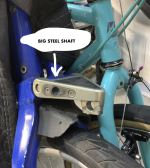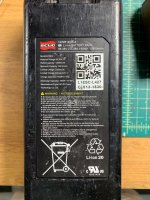Top Down
I've acquired an existing Ebike. I'm looking for some help/insight in trouble shooting 1. Understanding the current system. 2. Adapting this system to a new bike using the current motor and battery, and thus how to charge and test the system.
Background
I was given this "NYC ride-share bike" that was found trashed. I don't have any more info than that. The motor and battery seem good. I have NOT tested anything yet. Furthermore, I dismantled the entire bike and separated the harness, controller, small module, battery (battery goes into a dock that mounts to bottle cage) and the wheel with a hub motor.
Here’s what I know:
Components:
- Hub Motor: Bafang 8Fun 250
- Battery: SCUD (Model LF3614) 36V (468Wh/12880 mAh)
- Controller
- Small Module
- Torque sensor in the BB (Bafang)
Using the photo of the harness below, here’s what I think I understand:

1. The bikes charges by being pushed into the street dock with a piece we’ll call the "Steel Shaft"
2. From the looks of it. There is a 2 pin clip (marked unknown in the photo) that is shared with the tail light. It connects to the Steel Shaft (I think..) and goes to the small module.
3. Out of the small module, there’s also a headlight, and two (yellow and green wired) white clips.
4. One of the white clips goes to the controller.
5. The other white clip goes to the battery.
6. The bottle cage dock that the battery plugs into, currently has (4) wires coming from it. (2) x thick gauge black + red wires, and (2) thin green and yellow wires that go to the clip coming out the small module.
What I suspect is happening
- Because of these yellow and green wires… I’m lead to believe that small module is a communication module.
It connects to the battery and the controller, which ends on the Steel Shaft. When the steel shaft is plugged in, the communication module tells the system (cloud) that the bike is charging and where it’s charging.
- Another reason I believe this is a comm module is because the lights are tied to it. If the bike is moved… the lights flash.
What I want to figure out
1. Does this small module tell the battery when to discharge and charge, how can I test?
2. Can I run this system simply by by-passing this small module.
3. How can I charge this battery if the bottle cage doc has no input. It goes straight to the controller (Along with those little green/yellow wires)
My next steps would be:
- With spending as little money as possible, use the current system.
- Get a new controller (36/48V 22A), pas sensor, and display.
- I’m going to get a KT display and controller from Ebay since they are cheap and talk with each other.
- don’t foresee any issues with the controller recognizing the motor pug is the same. a common higo z9 or 910..
ANY INSIGHT WOULD BE APPRECIATED!
Other photos for reference




I've acquired an existing Ebike. I'm looking for some help/insight in trouble shooting 1. Understanding the current system. 2. Adapting this system to a new bike using the current motor and battery, and thus how to charge and test the system.
Background
I was given this "NYC ride-share bike" that was found trashed. I don't have any more info than that. The motor and battery seem good. I have NOT tested anything yet. Furthermore, I dismantled the entire bike and separated the harness, controller, small module, battery (battery goes into a dock that mounts to bottle cage) and the wheel with a hub motor.
Here’s what I know:
Components:
- Hub Motor: Bafang 8Fun 250
- Battery: SCUD (Model LF3614) 36V (468Wh/12880 mAh)
- Controller
- Small Module
- Torque sensor in the BB (Bafang)
Using the photo of the harness below, here’s what I think I understand:

1. The bikes charges by being pushed into the street dock with a piece we’ll call the "Steel Shaft"
2. From the looks of it. There is a 2 pin clip (marked unknown in the photo) that is shared with the tail light. It connects to the Steel Shaft (I think..) and goes to the small module.
3. Out of the small module, there’s also a headlight, and two (yellow and green wired) white clips.
4. One of the white clips goes to the controller.
5. The other white clip goes to the battery.
6. The bottle cage dock that the battery plugs into, currently has (4) wires coming from it. (2) x thick gauge black + red wires, and (2) thin green and yellow wires that go to the clip coming out the small module.
What I suspect is happening
- Because of these yellow and green wires… I’m lead to believe that small module is a communication module.
It connects to the battery and the controller, which ends on the Steel Shaft. When the steel shaft is plugged in, the communication module tells the system (cloud) that the bike is charging and where it’s charging.
- Another reason I believe this is a comm module is because the lights are tied to it. If the bike is moved… the lights flash.
What I want to figure out
1. Does this small module tell the battery when to discharge and charge, how can I test?
2. Can I run this system simply by by-passing this small module.
3. How can I charge this battery if the bottle cage doc has no input. It goes straight to the controller (Along with those little green/yellow wires)
My next steps would be:
- With spending as little money as possible, use the current system.
- Get a new controller (36/48V 22A), pas sensor, and display.
- I’m going to get a KT display and controller from Ebay since they are cheap and talk with each other.
- don’t foresee any issues with the controller recognizing the motor pug is the same. a common higo z9 or 910..
ANY INSIGHT WOULD BE APPRECIATED!
Other photos for reference





